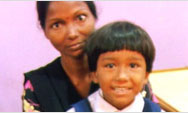 |
|
 |
 |
|
 |
 |
 |
| USAID Information:
External Links:
|
|
 |
 |
|
Burma
The Development Challenge: Conditions in Burma continue to reflect the State Peace and Development Council's (SPDC, formerly called SLORC) thus far successful effort to maintain political and military control of the country. Despite multiparty elections in 1990 that resulted in the main opposition party, the National League for Democracy (NLD), winning a decisive victory, SPDC refused to hand over power.
 |
|
Please note: All documents are in pdf format |
The military believes that it is the only institution capable of keeping Burma united as a single country, and that pluralism is destructive to national unity. It views economic progress, reform and liberalization as secondary to the maintenance of political control. The military is now more powerful than it has ever been, due to an aggressive recruitment program, improved weaponry, and cease-fire agreements with several ethnic armies that have allowed troops to be concentrated in fewer areas. The SPDC has signed cease-fire agreements with all but three armed insurgent groups representing the Shan, Karenni, and Karen ethnic groups. Extra-judiciary killings, torture, forced labor, portering, forced relocation, rape, and other abuses still commonly occur in most of the ethnic states of Burma.
U.S. Government policies are increasing pressure on the SPDC to engage in meaningful dialogue with the democratic opposition leading toward a peaceful transition to civilian rule. In 2002, the regime released NLD leader Aung San Suu Kyi from house arrest and freed of political prisoners. However, on May 30, 2003, Suu Kyi's convoy upcountry was attacked; several NLD supporters were killed or injured. This prompted the arrest of Suu Kyi and many party leaders as well as closure of all NLD offices and activities. As of this writing, Suu Kyi has been moved from jail to house arrest. This has been an enormous setback for the opposition and the potential for any type of reconciliation or talks about power sharing. The SPDC has since presented its own 'roadmap' to democracy, which has been met with much skepticism by the international community.
Economic policies and management by the Burmese Government have resulted in a deteriorating social and economic situation. U.S. sanctions following the May 30 attack of Suu Kyi's convoy and her subsequent arrest have intensified the regime's economic problems by causing closure of several factories and making it much more difficult for Burma to operate in the international arena due to restrictions on use of dollars. While statistics are hard to verify, most agree that at least 13 million of Burma's 48 million people (more than 25 percent of the population) live below the subsistence level of $1 per day. Health care facilities are eroding and HIV/AIDS and other infectious diseases are becoming endemic. Universities are sporadically open and the public education system is in very poor condition.
As a result of ethnic fighting and deteriorating economic conditions in Burma, more than 1.6 million people have fled the country, and an estimated 1.5 million more remain inside Burma as internally displaced people. Of the population that fled Burma, approximately 180,000 reside in refugee camps in Thailand and Bangladesh, while the majority live as illegal migrants in Thailand, Bangladesh, India, China, and Malaysia. Thailand alone hosts more than one million Burmese outside the camps.
U.S interests in Burma include promoting democracy, supporting human rights and religious freedom, fighting HIV/AIDS, furthering effective counter-narcotics efforts, recovering World War II remains, and promoting regional stability. The United States also pursues a global strategic goal of preventing or minimizing the human costs of conflict and natural disasters.
The USAID Program: USAID suspended assistance to Burma following the 1988 suppression of the pro-democracy movement. A FY 1993 earmark of $1 million reinstated USG assistance, initially through the Department of State's Bureau for Democracy, Human Rights and Labor (State/DRL). Since 1998, USAID has co-managed the Burma assistance program with the Department of State. Funding has been used to support democracy in Burma and pro-democracy groups outside Burma, and to meet the humanitarian needs of Burmese who reside in Thailand.
Currently, USAID administers the following activities:
- Humanitarian assistance activities that provide primary health care and basic education support to refugees living in refugee camps on the Thai-Burma border;
- Humanitarian assistance to provide access to health care for out of camp Burmese in Thailand; and
- Democracy activities that finance training for Burmese journalists and public information workers to improve the quality and dissemination of news and information on the situation inside Burma and fund scholarships for Burmese refugees to study at colleges and universities in Asia, Europe, Canada, Australia, and the U.S.
Other Program Elements: USAID carries out programs to address HIV/AIDs in Burma, and to reduce the spread of infectious diseases such as tuberculosis and malaria along the Thai-Burma border through the regional "Stabilize Population Growth and Protect Human Health" program (498-022). These activities are funded and managed by the Regional Development Mission/Asia. In addition, the Department of State's Population, Refugees and Migration Bureau funds refugee assistance programs that complement USAID activities on the Thai-Burma border. State/DRL also supports a grant to the National Endowment for Democracy and Prospect Burma.
Other Donors: The activities being funded under the earmark operate independently of the Burmese regime and are coordinated with more than 30 other donor agencies through either the Burma Donors Forum or the Coordinating Council for Support to Displaced Persons in Thailand. There are regular coordinating meetings, led by UNAIDS, among HIV/AIDS donors to try and maximize use of funds. Bilateral donors that focus on humanitarian assistance to Burma and to Burmese refugees include the Netherlands, Denmark, Sweden, Australia, and the United Kingdom. Multilateral donors with activities in Burma include the United Nations Children's Fund, the United Nations Development Program, the World Food Program, and the United Nations High Commissioner for Refugees.
Back to Top ^
|


